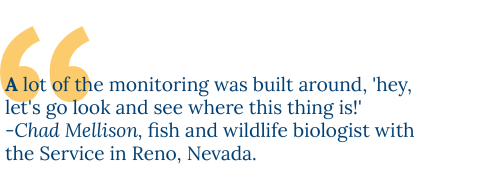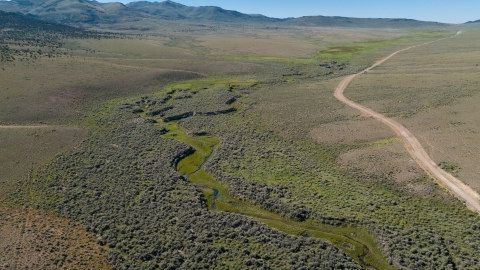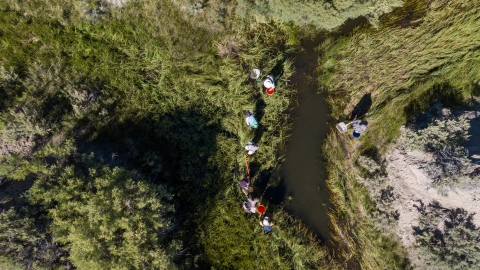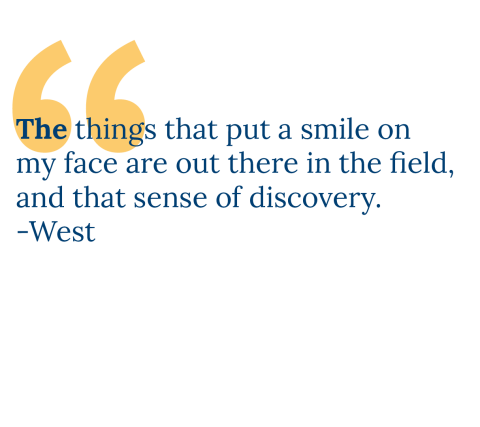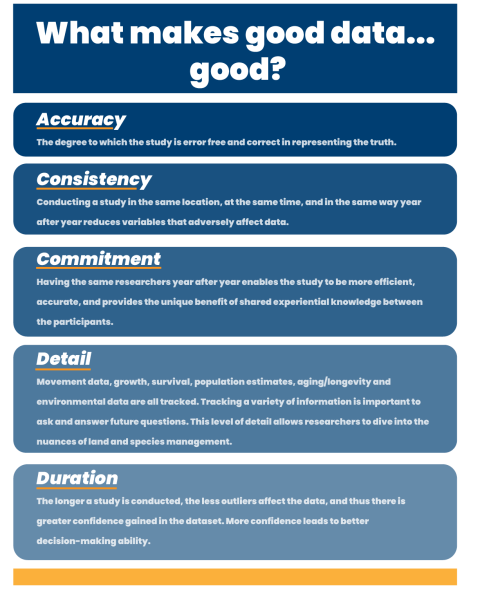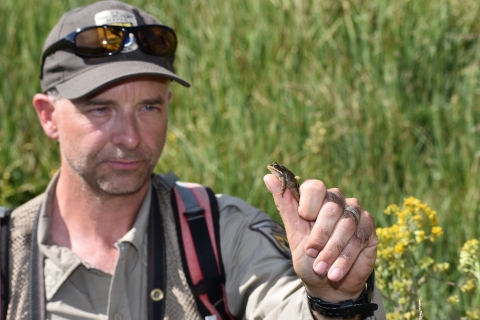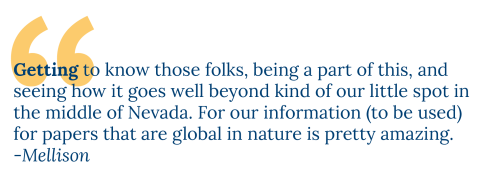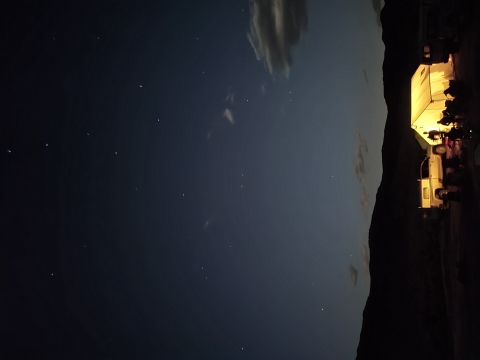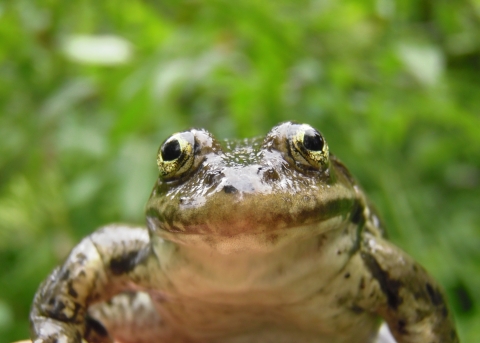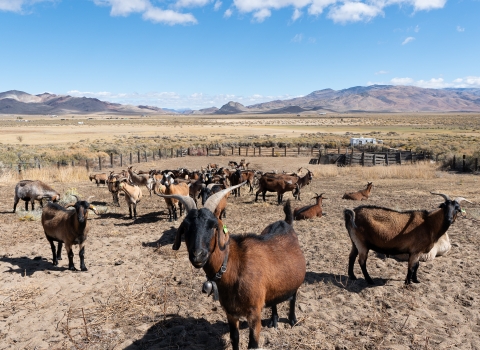As a kid, do you remember catching frogs in a small stream or pond? Maybe it was in your back yard or on a camping trip. These little critters are slimy and kind of bizarre looking, and to a child, fascinating. That fascination hasn’t faded for a group of folks working in northern Nevada. Starting in 2004, biologists and volunteers with the U.S. Fish and Wildlife Service, U.S. Forest Service, the Nevada Department of Wildlife, Nevada Division of Natural Heritage, Bureau of Land Management, and the University of Nevada Reno, have ventured into the Nevada desert every year to capture frogs. It’s not just for nostalgic fun however, this work plays an important role in the world of amphibian conservation.
The origins of 'Frog Week’
In 1994, the Columbia spotted frog became a candidate species (a species proposed to be listed as either endangered or threatened but hasn’t received a final determination). Although information about the frog populations in Idaho and Oregon were available at the time, its whereabouts in Nevada were largely unknown. At the southern end of its range, biologists in northern Nevada were essentially given a blank map to work with, so a joint effort to uncover the location of these high desert dwelling amphibians was put into place.
Photo courtesy of J. Forgette
A few hours southeast of Reno lies Indian Valley, the location chosen to monitor a population of Columbia spotted frogs. Here, a sliver of small ponds and creeks are hidden amid a sagebrush sagebrush
The western United States’ sagebrush country encompasses over 175 million acres of public and private lands. The sagebrush landscape provides many benefits to our rural economies and communities, and it serves as crucial habitat for a diversity of wildlife, including the iconic greater sage-grouse and over 350 other species.
Learn more about sagebrush ecosystem typical of northern Nevada. The valley serves as home base for a week full of catching, tagging, and monitoring frogs. Researchers first collected data in 2004, then returned the following year, again the next year, and the one after that too. The need to learn about the Columbia spotted frog’s population became an annual data collection event, one that has grown in influence and importance since its inception. This annual event is affectionately known as “Frog Week.”
What is surveying and monitoring?
Surveying and monitoring are species specific projects undertaken to understand an animal or plant’s population size, breeding numbers, genetics, movement, and more. Locating populations is the first part of this process. Surveys are done to first locate exactly where populations of the species exist. After confirming the location of the species, the next step is to catch individuals of a population in order to track them, but this work isn't always smooth sailing. When it comes to Columbia spotted frogs, their coloration makes them difficult to spot. Biologists search for the camouflaged frogs while wading in water that could be anywhere from 2-5 feet deep. The team scours a marsh-like environment equipped with nets to scoop up any frog they might come across. This goes on for hours throughout the day, rain or shine. Variable weather can provide hot summer days, occasional frosty mornings, or even thunderstorms. It's a day in the life at Frog Week.
Photo courtesy of J. Forgette
After catching an individual comes tagging and scanning for data collection. Once caught, Biologists scan the frogs for a PIT tag. These tags are small tracking devices, PIT stands for Passive Integrated Transponders, and are used to track the number of individuals in a population and their movement. When a frog is scanned and there is no tag, biologists will cut a small incision behind the neck and place the tag in the cut. The frog isn’t hurt, and the cut heals quickly. If the frog already has a tag, a member of the team can simply scan it and record the data. The frogs are then released back into their home. Researchers compile this data back in their offices and will do this work year after year to build a full dataset.
Considering the exhausting work participants choose to take part in, it is safe to say that Frog Week is a labor of love. Most people don't wake up one day and just decide to wade through chest deep water in search of frogs. For some, the passion and dedication for this work has been curated since childhood. Michael West, a Wildlife Diversity biologist for the department, has been preparing for this work since he was a child. “All the best training I had for my field career as a biologist was as a kid, five years old, running around in the woods, catching frogs, catching box turtles. That's where I learned how to do my field work,” said West.
Credit: Dan Hottle/USFWS
'Big, robust, and long term’
Trying to understand a species without data can be like traveling to a new destination with a blank map. Surveying and monitoring provide information to fill in the “map” to better inform future conservation and management efforts. With this data, biologists gain previously unknown insight into a species, understand the effectiveness of conservation work, and can ask and answer big picture questions related to evolution and climate change climate change
Climate change includes both global warming driven by human-induced emissions of greenhouse gases and the resulting large-scale shifts in weather patterns. Though there have been previous periods of climatic change, since the mid-20th century humans have had an unprecedented impact on Earth's climate system and caused change on a global scale.
Learn more about climate change .
Data collection in Indian Valley has carried on for 18 years now. Having consistency over this length of time reveals if the Columbia spotted frog population is growing, remaining the same, or declining. This information allows biologists to see how the population responds to drought, flooding, and other variable environmental conditions that would otherwise confuse a short-term study. “It’s big, it’s robust, and long term. That long term [piece] is really critical, and that allows researchers to delve into some of the nuances of ecological relationships of land management,” said West.
An example of how this long-term data set reveals the nuances of ecology took place nearly 10 years ago when biologists noticed a pattern in Columbia spotted frog's behavior, or rather, a blip in their normal patterns of behavior. In 2012 biologists noticed a frog passing by a monitoring antenna in the middle of October. “It was high-tailing it out of there,” said Mellison. He and others noticed this rare behavior and dug a little deeper into the data. “We noticed a large number of individuals moving around in October and November. This has never been documented before, a huge spike in numbers moving. So, we asked, ‘Why would they be moving in October and November when it's really cold? They should be shutting down for the winter.’ So, then the next year we record it and lo and behold, the exact same pond, exact same week the following year we caught them going through that antenna,” said Mellison.
Biologists unearthed a pattern in the data and learned that Columbia spotted frogs were splitting their time between winter and summer homes over the course of the year. Columbia spotted frogs require different habitats throughout their lifespan, so by understanding their movement, biologists can confidently determine which habitat improvement projects are undertaken and/or necessary.
In 2003 biologists made habitat improvements to Indian Valley by building ponds that aimed to provide more overwintering and breeding sites for the frogs. More ponds were built in 2009. But it’s not enough to just build ponds, it is crucial to understand the effect that they have. “Now that you have a long-term data set, you can start asking many more questions. One that we asked was, ‘Were the ponds that we built effective over time?’” said Mellison. "A paper was published very recently that used our data set and some other techniques to show that, yeah, [the restoration] actually was very effective.” Data gained from years of surveying provided biologists with proof that their work was beneficial to the Columbia spotted frogs in Indian Valley.
The hands-on, in-person, nature of this study also results in knowledge about subtle changes that occur over long periods of time, changes that would go unnoticed without annual observation. Mellison said that being there year–after year is important because it has taught him and others about drought and climate change impacts. “If you don't go out there consistently, then you can’t say much about what's happening (if it’s every five to ten years), because you haven't been there. But if you go there consistently, especially during drought cycles, you can track these things, say, ‘Oh, man, this site has never been dry, ever. And now all of a sudden, it is.’ You can start putting pieces together and say something about why some things (are) happening. This long-term knowledge, long term data set, can really tell us at large landscape scales how we're doing as managers of the land."
After 18 years of visiting the same sites, Frog Week attendees have become the experts in observing these subtle changes and understanding their impacts. "Everybody involved in this has seen it. It's no mystery that climate change is occurring. It's occurring in real time. And we wouldn't really have that knowledge to say that without us doing [the surveys every year.] The more we gather data, the more questions we're able to answer and fully document effects to the species and do some management to help,” said Mellison.
Credit: Dan Hottle/USFWS
By continually monitoring the health, behaviors, and habitats of species, biologists better understand both when and how to act. Because land managers have seen the changes on the landscape, confident predictions can be made regarding the impacts of a changing environment. This information lets conservationists intervene to protect a species before it becomes threatened, endangered, or extinct. Proactive conservation for a species is cheaper, less time consuming, and more effective, and it begins with collecting the right information.
The impact of Frog Week
So, what does all the surveying and monitoring mean for the Columbia spotted frog? Biologists found the populations were largely stable, although in distress due to drought, and the frog was found in its historic range, even in locations where it was thought to be extirpated from (locally extinct). Surveying has also revealed more areas around Nevada where Columbia spotted frog exists, extending the known range of the species.
Credit: USFWS
The data set resulting from more than a decade of collaboration between multiple agencies directly informed the Service’s 2015 determination that Columbia spotted frog did not require the protections of the Endangered Species Act. A decision arrived as a result of the ongoing research and data collection from the dedicated participants of Frog Week. This information goes beyond informing local conservation efforts and listing decisions, however. The data collected from Frog Week has been used in 15 publications so far and cited in global research papers, helping answer questions about amphibian evolution. Notably, the data set created from this work was published in Proceedings of the National Academy of Sciences and the journal Science. The 18 year, and counting, research is just beginning to leave a lasting mark on the global knowledge of amphibians.
When asked if Mellison thought back in 2004 that Frog Week would transform into what it is today, he replied, “No, not at all. Frog Week was born out of a need to collect scientific data to inform a federal listing determination. That's how it started. All this other stuff came about because we did good science.”
According to Mellison, the impact of Frog Week isn’t just felt in its scientific influence, the duration of this study has created strong personal connections. These connections play a large part in why people not only spend a full week trudging through a marshy environment in the summer, but they also look forward to it year after year. “We’ve had biologists and their children coming out this whole time. We've watched their kids grow up, every year, including my own, and that's just made it even more special,” said Mellison.
Frog Week's influence on science, people, and the species has grown remarkably since its humble beginnings. The satisfaction that Mellison and other biologists have in this research is clear, it is impossible to ask anyone involved about the work and results without hearing a gratified tone. “And that's what you get when you do good things out there and do good science. So, I'm very proud of this,” added Mellison.
Until next year...
Credit: Chad Mellison/USFWS
At the end of a long day, biologists and volunteers rest up at camp in an old, abandoned corral. People share stories about adventures, and misadventures, of the day. In this remote area of the Nevada desert, they hang out by the campfire, enjoying the moment with their families, new friends, and the satisfaction of a long day of good science. West said that in his 30 years of work, this week of surveying and monitoring is the “most productive, collaborative, and rewarding effort,” that he has been a part of. The lessons found in this project are the value of long term and precise data, proactive conservation, and collaborative work between agencies. What started out as the need to uncover the facts about the Columbia spotted frog in Nevada has evolved into an annual weeklong surveying/monitoring event, one with wide reaching impacts on science, people, and amphibians.
Credit: Rachel Van Horne/US Forest Service


